Squatting
Squatting is the action of occupying an abandoned or unoccupied area of land or a building, usually residential, that the squatter does not own, rent or otherwise have lawful permission to use. Author Robert Neuwirth suggested in 2004 that there were one billion squatters globally. Squatting occurs worldwide and tends to occur when people who are poor and homeless find empty buildings or land to occupy for housing. It has a long history, broken down by country below.
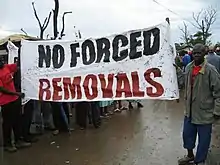

| Part of a series on |
| Libertarianism |
|---|
|
In developing countries and least developed countries, shanty towns often begin as squatted settlements. There are pavement dwellers and slums in India and South Africa, represented by several groups. In Hong Kong there are rooftop slums. In Brazil, there are favelas and large social movements of thousands of people. Squatted settlements are known in Spanish-speaking countries under various terms.
In industrialized countries, there are often squats and also political squatting movements, which can be anarchist, autonomist or socialist in nature, for example in the self-managed social centres of Italy or squats in the United States. Oppositional movements from the 1960s and 1970s created freespaces such as Freetown Christiania in Denmark or Ruigoord in the Netherlands, and in England and Wales, there were estimated to be 50,000 squatters in the late 1970s. Each local situation determines the context: in Athens, Greece, there are refugee squats; Germany has social centres; in Spain there are many squats. Squatting has recently been criminalised in the Netherlands completely and in residential buildings in England and Wales.
Overview
| Part of the Politics series on |
| Anarchism |
|---|
 |
|
| Part of a series on |
| Libertarian socialism |
|---|
 |
|
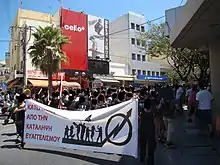
The majority of squatting is residential in nature. As a phenomenon it tends to occur when a poor and homeless population makes use of derelict property or land through urban homesteading.[1] According to author Robert Neuwirth, there were over 1 billion (one in seven) squatters worldwide in 2004. If current trends continue, this will increase to 2 billion by 2030 (one in four), and 3 billion by 2050 (one in three).[2] However, despite the numbers of people squatting, according to academic Kesia Reeve, "squatting is largely absent from policy and academic debate and is rarely conceptualised, as a problem, as a symptom, or as a social or housing movement."[3]
In many of the world's poorer countries, there are extensive slums or shanty towns, typically built on the edges of major cities and consisting almost entirely of self-constructed housing built without the landowner's permission.[4] While these settlements may in time become upgraded, they often start off as squats with minimal basic infrastructure. Thus, there is no legal link to sewerage, electricity or water.[5] Such settlements also exist in industrialized countries, such as for example Cañada Real on the outskirts of Madrid.[6]
Squatting can be related to political movements, such as anarchist, autonomist, or socialist. It can be a means to conserve buildings or a protest action. Squats can be used by local communities as free shops, cafés, venues, pirate radio stations or as multi-purpose autonomous social centres.[7] Dutch sociologist Hans Pruijt separates types of squatters into five distinct categories:[7]
- Deprivation-based – homeless people squatting for housing need
- An alternative housing strategy – people unprepared to wait on municipal lists to be housed take direct action
- Entrepreneurial – people breaking into buildings to service the need of a community for cheap bars, clubs etc.
- Conservational – preserving monuments because the authorities have let them decay
- Political – activists squatting buildings as protests or to make social centres
Adverse possession, also known as squatter's rights, is a method of acquiring title to property through possession for a statutory period under certain conditions.[8] Countries where this principle exists include England and the United States, based on common law.[9][10]
Anarchist author Colin Ward comments: "Squatting is the oldest mode of tenure in the world, and we are all descended from squatters. This is as true of the Queen [of the United Kingdom] with her 176,000 acres (710 km2) as it is of the 54 percent of householders in Britain who are owner-occupiers. They are all the ultimate recipients of stolen land, for to regard our planet as a commodity offends every conceivable principle of natural rights."[11] Others have a different view; UK police official Sue Williams, for example, has stated that "Squatting is linked to anti-social behaviour and can cause a great deal of nuisance and distress to local residents. In some cases there may also be criminal activities involved."[12] The public attitude toward squatting varies, depending on legal aspects, socioeconomic conditions, and the type of housing occupied by squatters. In particular, while squatting of municipal buildings may be treated leniently, squatting of private property can often lead to strongly negative reactions on the part of the general public and the authorities.[13]
Africa
The City of the Dead slum is a well-known squatter community in Cairo, Egypt.[14] Between 1955 and 1975, the Cairo authorities built 39,000 public housing apartments but 2 million people moved there, mostly ending up in informal housing. In Alexandria, Egypt's second city, public housing was only 0.5% of the total housing stock, whereas informal housing was 68%.[15]:108
An estimated 3,500 people live in the Grande Hotel Beira in Mozambique.[16] Informal settlements in Zambia, particularly around Lusaka, are known as kombonis.[17] As of 2011, 64% of Zambians lived below the poverty line, whilst the United Nations predicted a 941% population increase by 2100.[18][19]
South Africa
In South Africa, squatters tend to live in informal settlements or squatter camps on the outskirts of the larger cities, often but not always near townships. In the mid-1990s, an estimated 7.7 million South Africans lived in informal settlements: a fifth of the country's population.[20] The figure was estimated to be 15 million in 2004.[21] In Cape Town and Durban, there have been sustained conflict between the city council and a shack dwellers' movement known as Abahlali baseMjondolo. The organisation has represented the squatters in land occupations such as the Macassar Village in 2009 and the Cape Town and Durban Marikana land occupations in 2013 (both named after the Marikana massacre).[22][23] It also successfully challenged the KZN Slums Act, which sought to mandate the eviction of slums but was eventually declared unconstitutional.[24]
There have been a number of similar conflicts between shack dwellers, some linked with the Western Cape Anti-Eviction Campaign, and the city council in Cape Town. One of the most high-profile cases was the eviction of squatters in the N2 Gateway homes in the suburb of Delft, where over 20 residents were shot, including a three-year-old child. There have been numerous complaints about the legality of the government's actions.[25] Many of the families then squatted on Symphony Way, a main road in the township of Delft, before being forced to move to a camp called Blikkiesdorp.[26]
Asia
In China, informal settlements are known as urban villages.[27] Squatter settlements occurred in Hong Kong in 1946, after its wartime occupation by Japan.[28] After 700,000 people migrated from mainland China to Hong Kong between 1949 and 1950, the squatter population was estimated at 300,000 with people sleeping wherever they could find a space.[28] A fire at Shek Kip Mei in December 1953 resulted in over 50,000 slum-dwellers left homeless.[29] Rooftop slums then developed, when people began to live illegally on the roofs of urban buildings.[30]
Israeli settlements are communities of Israeli citizens living in the Palestinian territories. The international community considers the settlements in occupied territory to be illegal,[31][32] In March 2018, Israeli settlers were evicted from a house they had illegally occupied in Hebron, a Palestinian city in the West Bank. The fifteen families had argued that they had bought the house, but the High Court of Justice ruled that they had to leave. The Israel Defense Forces declared the building a closed military zone and it was unclear if the Palestinian owners could regain possession. The settlers had already occupied the house and been evicted in 2012.[33] In October 2018, Fatou Bensouda, the Chief Prosecutor of the International Criminal Court stated that Israel's planned demolition of Bedouin village Khan al-Ahmar could constitute a war crime.[34]
Squatters in Malaysia live on both privately owned and government-owned land.[35] Some squatters have lived on land owned by national electricity company Tenaga Nasional for over five decades.[36]
Squatters in Indonesia live on both privately owned and government-owned land. For example, the former Kalisosok Prison in Surabaya squatted since 2000s after being used as a prison for over 100 years.[37]
In Thailand, although evictions have reduced their visibility or numbers in urban areas, many squatters still occupy land near railroad tracks, under overpasses, and waterways. Commercial squatting is common in Thailand, where businesses temporarily seize nearby public real estate (such as sidewalks, roadsides, beaches, etc.) and roll out their enterprise, and at closing time they fold it in and lock it up, thus avoiding the extra cost of having to rent more property.[38] In the early 2000s, the government estimated that 37% of the population lived in low-income urban communities, over half of which were squatting public land or renting precariously. The National Housing Authority stated over 100,000 families were living under threat of immediate eviction.[21]:26
India
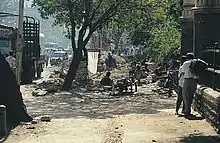
In Mumbai, there are an estimated 10 to 12 million inhabitants, and six million of them are squatters. The squatters live in a variety of ways. Some possess two- or three-story homes built out of brick and concrete which they have inhabited for years. Geeta Nagar is a squatter village based beside the Indian Navy compound at Colaba. Squatter Colony in Malad East has existed since 1962, and now, people living there pay a rent to the city council of 100 rupees a month. Dharavi is a community of one million squatters. The stores and factories situated there are mainly illegal and so are unregulated, but it is suggested that they do over $1 million in business every day.[39]
Other squatters are pavement dwellers, with very few possessions. Some activists are working for better living conditions for slum dwellers, through various organizations, such as Slum Dwellers International.[40] In the 2016 Mathura clash, members of Azad Bharat Vidhik Vaicharik Kranti Satyagrahi (Free India Legal Ideas Revolutionary Protesters) who had been living in Mathura's largest public park Jawahar Bagh for two years were evicted in a large police operation. At least 24 squatters were killed.[41]
Philippines
Squatting is a major issue in the Philippines especially but not exclusively in urban areas of the Philippines. After World War II many people were left homeless and they built makeshift houses called "barong-barong" on abandoned private land.[42] The first mass eviction on record in Manila was 1951 and the largest was in late 1963 and early 1964 when 90,000 people were displaced.[15]:43 By 1978, there were estimated to be two million squatters in Manila, occupying 415 different locations.[15]:77
In the early 1980s, the squatter population grew and the government of Ferdinand Marcos made attempts to relocate squatters to low-cost housing projects. The sites were not prepared well and moved people far away from their employment and social networks.[15]:45 Projects included the former Smokey Mountain landfill at Tondo, Taguig (BLISS Housing Project), and Rodriguez, Rizal. Philippine law distinguishes between squatters who squat because of poverty and those who squat in hopes of getting a payment to leave the property.[43] In 1982, Imelda Marcos referred to the latter group as "professional squatters [...] plain land-grabbers taking advantage of the compassionate society".[15]:46 Philippine-based media and journalists refer to squatters as "informal settlers."[44][45] The Community Mortgage Program was set up in 1992, aiming to help low-income families transition from squatting to affordable housing. By 2001, around 106,000 families had found secure housing in over 800 separate communities.[21]:54
Turkey
Gecekondu is a Turkish word meaning a house put up quickly without proper permissions, a squatter's house, and by extension, a shanty or shack. From the 1960s onwards, these settlements have provided a means of housing for poor workers and new migrants arriving in cities such as Ankara and Istanbul.[46][15]:89 From the 1980s onwards, property developers have upgraded many gecekondu areas.[46]
Shortly after the 2013 Gezi Park protests in Istanbul, Don Kişot (Don Quixote) was squatted in the Kadıköy district. It was stated to be the capital's first occupied and self-managed social centre;[47] Caferağa Mahalle Evi (community centre Caferağa), also in Kadıköy, was squatted soon afterwards and evicted in December 2014.[48][49] A place was occupied in Beşiktaş district of Istanbul on March 18, 2014 and named Berkin Elvan Student House, after a 15-year-old boy who was shot during the Gezi protests and later died.[50] Atopya was squatted in Ankara in June 2014 by anarchists, who claimed it was the city's first political squat.[51][52]
Europe, Central and Eastern
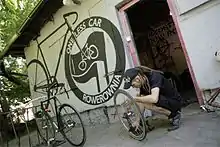
The trajectory of squatting in central and eastern Europe is very different from that of western Europe because, until recently, countries were part of the Communist Bloc and squatting is generally not tolerated.[53] The first public squat in Romania was Carol 53 in Bucharest, occupied in 2012 by artists. This was a controversial project because in running the project the artists evicted a Roma family which was already silently squatting there.[54] In Moldova, homeless people live in state-run shelters or squatter camps.[55] Squatters in Centro 73, Moldova's first squatted, self-managed social centre, attempted to prevent the historical building's demolition, but were quickly evicted and given another building for art events.[56][57] The oldest squat in Poland, Rozbrat, was founded in 1994 through the occupation of a former paint factory in Poznań. There are also squats in Białystok, Gdańsk, Gliwice, Warsaw and Wrocław.[53] Ljubljana, the capital of Slovenia has two large social centres, namely a former military barracks called Metelkova and a former bicycle factory called Rog.[58][59]
In 1980s Soviet Russia there was a practice used by artists and musicians to acquire communal rooms and then expand into other rooms. Following the dissolution of the Soviet Union, there were many collectively organised housing occupations by families and refugees. The groups would attempt to legalise in some cases and not in others. There were also art squats, for example in Saint Petersburg there were Pushkinskaya 10, Na Fontanke and Synovia doktora Pelia.[60] In the early 1990s, the Government of Moscow prepared to renovate buildings then ran out of money, meaning that squatters occupied prime real estate. By 1996, 40% of Tverskaya Street rented illegally or squatted.[61]
Squatting in the Czech Republic began in its modern form when anarchist and punk activists inspired by squatting movements in Amsterdam and Berlin occupied derelict houses following the 1989 Velvet Revolution.[62] Ladronka (1993-2000) became internationally famous as a hub for counter-cultural activities and anarchist organisation.[63] Squat Milada was occupied in 1997 and evicted in 2009. Its longevity was in part due to the building not existing in the cadastre.[62] Klinika was an occupied social centre between 2014 and 2019.[64] These three social centres, all in Prague, were the city's three most important political squats.[65]
Starting from December 2012, Greek Police initiated extensive raids in a number of squats in Athens, arresting and charging with offences all illegal occupants (mostly anarchists). Squats including Villa Amalia were evicted.[66] A march in support of the 92 arrestees drew between 3,000 and 8,000 people.[67] After Villa Amalia, Villa Skaramanga and then Villa Lela Karagianni were evicted. Lela Karagianni had been squatted since 1998 and was later reoccupied.[68] The name came from the street, named for a Greek World War II resistance leader of that name. From 2015 onwards Athens has seen refugee squats in response to the European migrant crisis which are anarchist and self-organised.[69] In 2019, several squats in Exarcheia were evicted by the Greek state. Some of the migrants evicted set up a camp outside the Parliament at Syntagma Square.[70]
Europe, Western
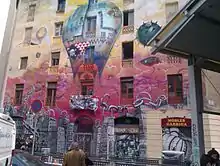
In many West European countries since the 1960s and 1970s, there are squatted houses used as residences and also larger squatted projects where people pursue social and cultural activities.[7]
There was a large squatting movement in the newly formed state of Austria following the First World War. Famine was a significant problem for many people in Austria and the "Siedler" (settler) movement developed as these people tried to create shelter and a source of food for themselves.[71] The Ernst Kirchweger Haus (EKH) in Vienna was squatted as a social centre in 1990 and legalised in 2008. In 2014, 1,500 riot police officers, a tank-like police vehicle, a police water cannon and helicopters were used to clear a building occupied by the group Pizzeria Anarchia in Vienna.[72] [73]
Christiania in Copenhagen, Denmark is an independent community of almost 900 people founded in 1971 on the site of an abandoned military zone. In Copenhagen, as in other European cities such as Berlin and Amsterdam, the squatter movement was large in the 1980s. It was a social movement, providing housing and alternative culture. A flashpoint came in 1986 with the Battle of Ryesgade. Another flashpoint came in 2007 when Ungdomshuset was evicted. While not technically a squat until 14 December 2006, it was a social centre used by squatters and people involved in alternative culture more generally. After a year of protests, the city council donated a new building.[74]
In early twentieth century France, several artists who would later become world-famous, such as Guillaume Apollinaire, Amedeo Modigliani and Pablo Picasso squatted at the Bateau-Lavoir, in Montmartre, Paris. Paris moved to legitimize some popular artist squats in the mid-2000s by purchasing and renovating the buildings for artist–residents. An example is Les Frigos.[75] In the 2010s there have been several land squats protesting against large infrastructure projects. These are known collectively as Zone to Defend or ZAD (French: zone à défendre). The first and largest was the ZAD de Notre-Dame-des-Landes, which successfully opposed an airport project near Nantes.[76]

Geneva in Switzerland had 160 buildings illegally occupied and more than 2,000 squatters, in the middle of the 1990s.[77] The RHINO (Retour des Habitants dans les Immeubles Non-Occupés, in English: Return of Inhabitants to Non-Occupied Buildings) was a 19-year-long squat in Geneva. It occupied two buildings on the Boulevard des Philosophes, a few blocks away from the main campus of the University of Geneva. The RHINO organisation often faced legal troubles, and Geneva police evicted the inhabitants on July 23, 2007.[77] There were large riots in Zürich when the Binz occupation was evicted in 2013. The squatters moved to another building.[78]
England
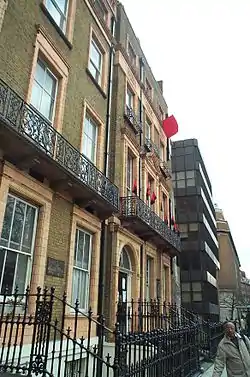
In England, squatting has a long historical tradition.[79] The BBC states that squatting was "a big issue in the Peasants' Revolt of 1381 and again for the Diggers in the 17th Century [who] were peasants who cultivated waste and common land, claiming it as their rightful due" and that squatting was a necessity after the Second World War when so many were homeless.[80] Mass squats were organised in a number of prominent public buildings in Central London, culminating in the occupation of the Queen Mother's ex-residence at 144 Piccadilly in 1969 which became known as 'Hippydilly' and made world headline news[81] and the media created what one of the leaders later described as a moral panic. There were estimated to be 50,000 squatters throughout Britain in the late 1970s, with the majority (30,000) living in London.[82] The BBC reported in 2011 that the government estimated that there were "20,000 squatters in the UK" and "650,000 empty properties".[80] However, trespassing in a commercial building is not a criminal offence as of 1 September 2012.[83] In 2018, Law Business Research reports, as a result, several sources saying trespassers have focused on commercial properties leading to calls to criminalise all trespassing.[83] Section 61 of the Criminal Justice and Public Order Act 199 provides police with additional power to remove trespassers when there is damage to land or property, trespassers are abusive, insulting or threatening or there are over six vehicles on premises related to squatters.[83]
On 1 September 2012, under Section 144 of the Legal Aid, Sentencing and Punishment of Offenders Act 2012, squatting in residential property was criminalised by the Government, punishable by up to six months in prison or a £5000 fine, or both.[84][85] The same year saw the first successful prosecution for squatting, resulting in a 12-week jail sentence.[86]
Germany
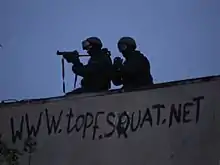
In the 1970s, squatting in West German cities led to "a self-confident urban counterculture with its own infrastructure of newspapers, self-managed collectives and housing cooperatives, feminist groups, and so on, which was prepared to intervene in local and broader politics".[87] The Autonomen movement protected squats against eviction and participated in radical direct action. After the German reunification, many buildings were vacated due to the demise of former state-run enterprises and migration to the western parts of Germany, some of which were then occupied by squatters. In Berlin, the now-legalised squats are in desirable areas such as Mitte and Prenzlauer Berg. Before the reunification, squats in Berlin were mostly located in former West Berlin's borough of Kreuzberg. The squats were mainly for residential and social use. Squatting became known by the term instandbesetzen, from instandsetzen ("renovating") and besetzen ("occupying").[7]
Well-known squats include Køpi and Rote Flora.[88][89] Legalised housing projects include Hafenstraße in Hamburg and Kiefernstraße in Düsseldorf.[90][91] Squatting can also take place for campaigning purposes, such as the Anatopia project, which protested against a Mercedes-Benz test track.[92] Squatters moved into the former factory site of J.A. Topf & Söhne in Erfurt in April 2001 and remained there until they were evicted by police in April 2009. The firm made crematoria for Nazi concentration camps. The squatters ran culture programs which drew attention to the history of the company. The occupation was known simply as Das Besetzte Haus (the occupied house) and was one of the most well known actions of left-radicals of that period in Germany. A book about the occupation was published in 2012, entitled Topf & Söhne – Besetzung auf einem Täterort (Topf & Söhne – Occupation of a crime scene).[93]
Iceland
.jpg.webp)
In Reykjavík, the capital of Iceland, there is a small tradition of squatting. In 1919, anarchists occupied a building and were quickly evicted.[94] Squatters occupied an empty house in downtown Reykjavík on Vatnsstigur street in April 2009.[95] The squatters set up a freeshop and had plans for a social centre, but the occupation was quickly evicted by the police and 22 people were arrested.[96] Vatnsstigur 4 was briefly resquatted on May 7, 2009, in solidarity with the Rozbrat squat in Poland, which was threatened with eviction.[97] Also in 2009, a group of graffiti artists called the Pretty Boys occupied Hverfisgata 34. Their intention was to make a clandestine gallery and then when they were not evicted, they legalised the space and called it Gallery Bosnia.[98]
When the Reykjavíkur Akademían (the Reykjavík Academy) was evicted at short notice from Hringbraut 121 in November 2011, it was occupied in protest. The space, which had hosted lectures and also Iceland's trade union and anarchist libraries, was moved to another location but the occupiers were unhappy that the new use of the building would be a guest house for tourists. An art exhibition was organised, with a camera obscura, live music and shadow theatre.[99]
Ireland
The exact legal position of squatting in Ireland is ambiguous and the mechanisms for removing squatters from properties varies from case to case, sometimes going through the judicial process, other times not. Trespass and occupation of a property is not illegal, but as a definitive process for dealing with squatters does not exist, unlawful evictions do occur,[100] sometimes with the support of the Garda Síochána (Irish Police).[101] However certain 'squatters rights' do exist and can be invoked in the form of adverse possession. An occupant is entitled to legal possession of the title provided they are in continuous and uninterrupted occupation of the property for 12 years.[102]
Squatting has no major tradition in Ireland, arguably in part due to the perceived strong position of the title holder. It has largely been confined to major cities but with the construction of Ghost estates across the country there has also been a rise in occupations of residential spaces in rural areas.[103] Many young people emigrated from Ireland in the 1980s and squatted in London.[104]
Activists from Occupy Cork squatted a National Asset Management Agency (NAMA) building in Cork at Christmas 2011, with the intention of using it as a community resource centre.[105] In Dublin, housing activists occupied Disco Disco on Parnell Square in July 2003; they were evicted within 24 hours.[106] From 2003 to 2004 the Magpie Squat was a residential space which housed activists on Upper Leeson Street. It had a library and a vegetable garden.[106]
With squatting becoming more public in the 2010s, Dublin hosted the 2014 International Squatter Convergence, which had previously been held in cities such as Brighton, Dijon, Berlin and Leeds. Events were hosted by Seomra Spraoi, a self-managed social centre.[107] Squatting also became popularised by the successful neighbourhood resistance to an attempted eviction of a large community used squatted space in Grangegorman in Dublin city in 2015.[108] The news of the eviction attempt and eventual successful resistance spread across social media[109] and international news.[110] The squatted complex enjoyed widespread support in the area and was also publicly supported by the city's Lord Mayor, Christy Burke[111] and by Irish Times journalist Una Mullally.[112] The building which once housed Neary's Hotel on Parnell St in Dublin's north inner city, was occupied in 2015 and renamed The Barricade Inn by squatters.[113][114]
Italy
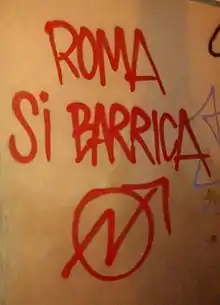
In Italy, despite the lack of official data, it appears that about 50,000 buildings all over the country are unused or abandoned and thus subject to squatting.[115] Squatting has no legal basis, but there are many squats used as social centres. The first occupations of abandoned buildings began in 1968 with the left-wing movements Lotta Continua and Potere Operaio. Out of the breakup of these two movements was born Autonomia Operaia, which was composed of a Marxist–Leninist and Maoist wing and also an anarchist and more libertarian one. These squats had Marxist-Leninist (but also Stalinist and Maoist) ideals and came from the left wing of Autonomia. The militants of the Italian armed struggle (the New Red Brigades) were connected to these squats.[116] There are many left-wing self-organised occupied projects across Italy such as Cascina Torchiera and Centro Sociale Leoncavallo in Milan and Forte Prenestino in Rome. In Rome there is also a far-right social centre, Casa Pound.[117]
This situation has so far received the approval of Italian courts, which have been reluctant to defend the owners' good reasons. In contrast with the dominant jurisprudence, new case-law (from the Rome Tribunal and the Supreme Court of Cassation) instructs the government to pay damages in case of squatting if the institutions have failed to prevent it.[118]
Netherlands
The Dutch use the term krakers to refer to people who squat houses with the aim of living in them (as opposed to people who break into buildings for the purpose of vandalism or theft).[7] Notable squats in cities around the country include ACU and Moira in Utrecht, the Poortgebouw in Rotterdam, OCCII, OT301 and Vrankrijk in Amsterdam, the Grote Broek in Nijmegen, Vrijplaats Koppenhinksteeg in Leiden, De Vloek in the Hague and the Landbouwbelang in Maastricht. Land squats include Ruigoord and Fort Pannerden.
On 1 June 2010, squatting in the Netherlands became illegal and punishable when a decree was sent out that the squatting ban would be enforced from 1 October.[119] Following legal challenges, on October 28, 2011, the Supreme Court of the Netherlands decided that the eviction of a squat can only occur after an intervention of a judge.[120] The Dutch government assessed the effectiveness of the new law in 2015, releasing a report giving statistics on arrests and convictions between October 2010 and December 2014. During this time period, 529 people have been arrested for the act of occupying derelict buildings in 213 separate incidents. Of the 529 arrests, 210 were found guilty. Of those convicted, 39 people were imprisoned for the new offence.[121]
Northern Ireland
In the late 1960s, people in Northern Ireland were forced to squat through both poverty and a lack of decent housing. In County Tyrone, there were allegations of unfair housing provision on the basis of politics and religion.[122] When a house in the village of Caledon, near Dungannon, was allocated to a young Protestant woman, Emily Beattie, it caused protests.[123] She was secretary to a solicitor who worked for the Unionist councillor who had given her the house and two Catholic families who had been overlooked complained that the same councillor had scotched plans to build houses for Catholics in the Dungannon area. Several days after the woman had moved in, the Catholic squatters in the house next door were evicted. Austin Currie, then a young politician, complained both at the local council and at Stormont about the situation. He then symbolically occupied the woman's house for a few hours, before being evicted by the Royal Ulster Constabulary (RUC). One of the policeman was the woman's brother who himself moved into the house later on.[122] The incident quickly became a media sensation and in August the civil rights movement arranged one of its first marches, from Coalisland to Dungannon. This was followed in October by a civil rights march in Derry which was organised by the Derry Housing Action Committee and the Northern Ireland Civil Rights Association. The march was brutally repressed by the RUC.[122]
In 2012 activists from Occupy Belfast squatted a Bank of Ireland building in Belfast city centre and used it as a social space.[124] Squatting in Northern Ireland was unaffected by the recent law change in England and Wales and remains a civil matter.[125]
Scotland
Squatting is a criminal offence in Scotland, punishable by a fine or even imprisonment, under the Trespass (Scotland) Act 1865. The owner or lawful occupier of the property has the right to evict squatters without notice or applying to the court for an eviction order, although when evicting, they cannot do anything that would break the law, for example, use violence.[126][125] Nevertheless, the 19th and early 20th centuries saw various land raids in which cottars attempted to occupy land for subsistence farming. In 1948, the Seven Men of Knoydart unsuccessfully squatted land owned by the Nazi-supporting Lord Brocket.[127] The Forest Café in Edinburgh squatted its old premises in 2011 before moving to a new site.[128] There have been several road protest land squats such as Bilston Glen and Pollok Free State.[129][130]
Spain
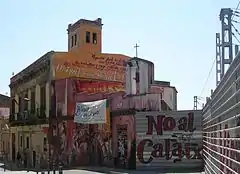
In Francoist Spain migrant workers lived in slums on the periphery of cities.[131] After the Spanish transition to democracy, residential squatting occurred in Spanish cities such as Barcelona, Bilbao, Madrid, Valencia and Zaragoza.
The number of squatted social centres in Barcelona grew from under thirty in the 1990s to around sixty in 2014, as recorded by Info Usurpa (a weekly activist agenda).[131]:113 The influential Kasa de la Muntanya was occupied in 1989.[131]:104 In 2014, the ultimately unsuccessful attempts to evict the long-running social centre of Can Vies provoked major riots.[132] Another long-running squat is Can Masdeu, which survived a concerted eviction attempt in 2002. Eleven occupiers suspended themselves off the walls of the building for several days.[131]:114
Younger squatters set up self-managed social centres which hosted events and campaigns. The 1995 Criminal Code among other things criminalised squatting, but failed to stop it.[133] Social centres exist in cities across the country, for example Can Masdeu and Can Vies in Barcelona and Eskalera Karakola and La Ingobernable in Madrid.[131][134][135] In the Basque Country the centres are known as gaztetxes. A well-known example was Kukutza in Bilbao.[136]
Wales
In 2010, a representative of the UK Bailiff Company claimed that the number of people squatting in Wales was at its highest for 40 years.[137] The high number of businesses failing in urban Wales has led to squatting becoming a growing issue in large cities like Swansea and Cardiff.[138][139] Experts said "the majority [of squatters] are forced into the lifestyle by financial pressures." Based on the internal database of UK Bailiff Company, there were 100 cases of squatting in 2009, the highest for 40 years, following trends estimated by the Advisory Service for Squatters that squatting has doubled in England and Wales since 1995.[137]
As with England, from 1 September 2012, squatting in a residential building was made a criminal offence subject to arrest, fine and imprisonment.[140] In December 2012 Cardiff Squatters Network was formed, to network together squatters citywide, and host "skill-share" workshops on squatting legally in commercial buildings.[141]
North America
| Squatting in the United States | ||||||
|---|---|---|---|---|---|---|
| International context | ||||||
| Legal acquisition | ||||||
|
||||||
| Housing and justice | ||||||
| Notable squats | ||||||
Canada
In Canada, there are two systems to register the ownership of land. Under the land title system, squatter rights, formally known as adverse possession, were abolished. However, under the registry system, these rights have been preserved. If a person occupies land for the required period of time as set out in provincial limitation acts and during that time no legal action is taken to evict them, then the ownership of the land transfers from the legal owner to the squatter.[142]
The Frances Street Squats in Vancouver were a row of six buildings squatted for nine months in 1990. They were evicted in a large operation and a film was subsequently made, called The Beat of Frances Street. In recent years, there have been a number of public squats which have brought together the two main contemporary reasons for squatting – homelessness and activism. Examples are the Lafontaine squat in Overdale, a district of Montréal (2001),[143] the Woodward's Squat in Vancouver (2002), the Infirmary Squat in Halifax (2002), the Pope Squat in Toronto (2002), the Seven Year Squat in Ottawa (2002), the Water Street Squat in Peterborough (2003), and the North Star hotel in Vancouver (2006). These were squats organised by anti-poverty groups which tended to have a short life expectancy.[144] The Woodward's building was a derelict department store which had stood empty for nine years. After being evicted from the building, two hundred squatters set up a tent city on the pavement outside.[145] The action is credited with putting in motion the eventual redevelopment of the building.[146] The Peterborough Coalition Against Poverty (PCAP) publicly squatted 1130 Water Street, a building which stood empty after a fire. The group offered to repair the place and return it to its use as low-income housing. City officials agreed to the repairs and then City Council voted to demolish the building. The cost of demolition was $8,900 and the cost of repairs had been projected to be $6,900.[144] The North Star hotel was temporarily squatted as a protest against emptiness by the Vancouver Anti-Poverty Committee.[147]
In 2011, the 'Occupy Toronto squat team' squatted a basement at 238 Queen Street West and offered to take on a lease for 99 cents per year. They were evicted after eight hours.[148]
United States
In the history of the United States, squatting occurred during the California Gold Rush and World War II.[149][150] Hoovervilles were homeless camps built across the country during the Great Depression in the 1930s. Hoovervilles were shanty towns built by homeless people during the Great Depression in the 1930s. They were named after Herbert Hoover, who was president of the country at the time.[151] In the late 2000s, shanty towns again sprang up across the US.[152] During the Great Recession (2007–2009) there were increasing numbers of people squatting foreclosed homes.[153][154] There were also reports of people resquatting their own foreclosed homes.[155]
Community organizations have helped the homeless to take over vacant buildings not only as a place to live but also a part of larger campaign to shine a light on inequity in housing and advocate change in housing and land issues.[156] In 2002, when the New York City administration agreed to work with eleven squatted buildings on the Lower East Side in a deal brokered by the Urban Homesteading Assistance Board with the condition the apartments would eventually be turned over to the tenants as low-income housing cooperatives.[157]
Latin America
Shanty towns exist on the periphery of many Latin American cities. In most countries new settlements result from land invasions and squatting, although in Colombia the informal settlements around Bogotá are bought legally to begin with and then subdivided or developed illegally.[158] In Peru, the name given to the squatter zones is pueblos jóvenes (literally "young towns").[159] In the 1980s, there were more than 300 pueblos jóvenes surrounding the capital Lima, housing over one million people.[15]:76 In Argentina they are known as villa miseria (literally "misery settlement"), and as asentamiento in Uruguay and Guatemala.[15]:13[160][161] It was estimated in 1982 that over 600,000 people in Guayaquil, Ecuador's largest city, squatted on self-built structures over swamplands or lived in inner city slums.[15]:25, 76
During the 1950s and 1960s, many Latin American cities demolished squatter settlements and would quickly evict land invasions. [15]:41–42 In Chile, the government of Eduardo Frei Montalva (1964-1970) began to permit shanty towns and the government of Salvador Allende (1970-1973) encouraged them, but under the military junta from 1973 onwards squatters were again quickly evicted.[15]:91 Likewise in Argentina, under the military dictatorship there was a zero tolerance policy.[15]:42 Nevertheless, forced by hunger and unemployment to take action, 20,000 squatters occupied 211 hectares of disused privately owned land on the periphery of Buenos Aires in 1981, forming six new settlements. They collectively resisted the eviction attempts and by 1984 had outlasted the dictatorship. The election of a democratic government led to the local councils becoming more open to negotiation.[15]:13–15
More recently governments have switched from a policy of eradication to one of giving squatters title to their lands, as part of various programs to move people out of slums and to alleviate poverty.[162] Inspired by the World Bank and the thinking of economists such as Hernando de Soto, the programs aim to provide better housing and to promote entrepreneurship since the former squatters can use their houses as collateral to secure business loans.[158] The former squatters found that it was hard to maintain the property title over time after deaths or divorces and that banks changed their loan requirements so as to exclude them.[162][158]
Brazil
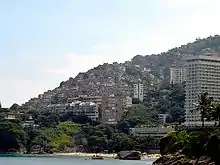
In Brazil, squatter communities are called favelas, and a famous example is Rocinha in Rio de Janeiro, home to up to 180,000 people.[163] Favelas are mostly inhabited by the poorest strata of society, and usually lack much infrastructure and public services, but in some cases, already have reached the structure needed for a city. They are equivalent to slums or shanty towns, and typically occupy unused land (instead of unused or abandoned buildings). There were 25 million people living in favelas across Brazil, as of 2004.[2] After failed attempts in the 1960s and 1970s to bulldoze slums out of existence, the authorities moved towards a policy of toleration.[15]:29, 41
In Recife, the state capital of Pernambuco in the northeast of the country, 193 favelas were listed in 1985, which meant that half the population of city was squatting.[15]:32 In São Paulo, until 1972 favelas were usually demolished then afterwards they were permitted, meaning that in the next decade the number of squatters rose to one million.[15]:83, 92 The largest favela is Heliópolis, with over 200,000 inhabitants as of 2018. It has been officially recognized as a regular neighborhood of the city.[164] There are also a number of squatter buildings in the inner city, the most famous of which was a 22-storey building called Prestes Maia, whose inhabitants were ordered to leave in 2006.[165] The former Hotel Santos Dumont on Mauá Street in the Luz neighbourhood was occupied in 2007 after being derelict for 17 years. An estimated 1,000 people were living in the building, paying a small amount every month to cover maintenance. The community expels people who fight, use drugs or abuse alcohol.[166] Inspired both by this movement and increasing property speculation and gentrification, various occupations in buildings and unoccupied areas in big cities, led by groups such as the Homeless Workers' Movement (MTST) or Downtown Roofless Movement (MSTC).[167]
There are also rural squatter movements in Brazil, such as the Landless Workers' Movement (MST). The MST was formed from 1979 onwards and organised land occupations. For example in Pontal do Paraná in the state of Paraná 112 occupations were carried out, housing 6,500 families. It joined Via Campesina in 1996.[168]
Oceania
Australia
In the 19th century, the British government claimed to own all of Australia and tried to control land ownership. Wealthy farmers of livestock claimed land for themselves and thus were known as squatters.[169] This type of squatting is covered in greater detail at Squatting (Australian history).
In more recent times, Australia has seen occupations in Canberra, Melbourne and Sydney. The Aboriginal Tent Embassy was set up in 1972 and is a permanent protest occupation. The 2016 Bendigo Street housing dispute saw squatters successfully contesting road-building plans. The Midnight Star squat was used as an self-managed social centre in a former cinema, before being evicted after being used as a convergence space during the 2002 World Trade Organization meeting.[170]
See also
- Claim club
- Squatters union
- Treesitting
- Temporary use
References
- Peñalver, Eduardo M. (March 25, 2009). "Homesteaders in the Hood". Slate Magazine. Archived from the original on April 9, 2009. Retrieved April 17, 2009.
- Neuwirth, R. (2004), Shadow Cities: A Billion Squatters, A New Urban World, Routledge, ISBN 978-0-415-93319-3
- Reeve, Kesia (2005), "Squatting Since 1945: The enduring relevance of material need", in Somerville, Peter; Sprigings, Nigel (eds.), Housing and Social Policy, London: Routledge, pp. 197–216, ISBN 978-0-415-28366-3
- Encroachments and the Mystery of Capital. Archived 2020-08-08 at the Wayback Machine Political Economy – Development: Domestic Development Strategies eJournal. Social Science Research Network (SSRN). Accessed 16 April 2020.
- "What Is Urban Upgrading?". The World Bank Group. Archived from the original on 28 May 2013. Retrieved 1 October 2020.
- Tremlett, Giles (16 November 2009). "Drug clans take control in shanty town where Madrid's politicians fear to tread". The Guardian. Archived from the original on 3 October 2020. Retrieved 1 October 2020.
- Pruijt, Hans (2011). "Logic of Urban Squatting". International Journal of Urban and Regional Research: 1–8. Archived from the original on 2016-03-05. Retrieved 2015-11-05.
- "Adverse Possession". LII / Legal Information Institute. Cornell Law School. Archived from the original on 3 October 2020. Retrieved 1 October 2020.
- Doskow, Emily. "State-by-State Rules on Adverse Possession". www.nolo.com. Archived from the original on 15 November 2020. Retrieved 13 December 2020.
- Cobb, Neil; Fox, Lorna (June 2007). "Living outside the system? The (im)morality of urban squatting after the Land Registration Act 2002" (PDF). Legal Studies. 27 (2): 236–260. doi:10.1111/j.1748-121X.2007.00046.x. Archived (PDF) from the original on 2020-12-17. Retrieved 2020-12-16.
- Wates, Nick; Wolmar, Christian (1980). Squatting: the Real Story. London: Bay Leaf Books. ISBN 0-9507259-0-0.
- "Statement from Detective Chief Superintendent Sue Williams, Borough Commander and Chair of the Community Safety Partnership" (Press release). London Borough of Redbridge. 2012-01-20. Archived from the original on 2012-05-16. Retrieved 2012-03-22.
- Elms, Robert (November 22, 2011). "Squatting: The need for shelter versus property rights". BBC. Archived from the original on November 17, 2018. Retrieved June 20, 2018.
- Sims, David (2010). Understanding Cairo: The logic of a city out of control. Cairo: The American University in Cairo Press. ISBN 9789774164040.
- Hardoy, Jorge Enrique; Satterthwaite, David (1989). Squatter citizen: Life in the urban third world. London: Earthscan. ISBN 9781853830204.
- "In pictures: The squatters of Mozambique's Grande Hotel". BBC News. 21 April 2016. Archived from the original on 3 October 2020. Retrieved 1 October 2020.
- Myers, Garth (24 February 2016). Urban Environments in Africa: A Critical Analysis of Environmental Politics. Policy Press. ISBN 9781447322924.
- Smith, Georgina (24 October 2011). "Population growth in Zambia: A view from the slums". The Guardian. Retrieved 21 December 2020.
- Rogers, Simon (6 May 2011). "World population by country: UN guesses the shape of the world by 2100". The Guardian. Retrieved 21 December 2020.
- Saff, Grant (1996). "Claiming a Space in a Changing South Africa: The 'Squatters' of Marconi Beam, Cape Town". Annals of the Association of American Geographers. 86 (2): 235–255. doi:10.1111/j.1467-8306.1996.tb01752.x. ISSN 0004-5608. JSTOR 2564004.
- Mitlin, Diana; Satterthwaite, David (2004). Empowering squatter citizen: Local government, civil society, and urban poverty reduction. London: Earthscan. ISBN 9781844071012.
- Elliott, Caroline (10 May 2013). "South Africa's poor resist home attacks". Red Pepper. Archived from the original on 17 December 2020. Retrieved 17 December 2020.
- Pithouse, Richard (24 September 2013). "Durban's Brutal Underside". Counter Punch. Archived from the original on 17 December 2020. Retrieved 17 December 2020.
- Selmeczi, Anna (14 April 2011). "'From shack to the Constitutional Court'The litigious disruption of governing global cities". Utrecht Law Review. 7 (2): 60. doi:10.18352/ulr.162.
- "No compassion for people who do not drive a Porsche?". Constitutionally Speaking. Archived from the original on 2012-07-14. Retrieved 2019-04-30.
- Lali, Vincent (29 June 2018). "Blikkiesdorp residents frustrated by housing delays". Ground Up. Archived from the original on 30 April 2019. Retrieved 30 April 2019.
- Liu, Yuting; He, Shenjing (2010). "Chinese Urban Villages as Marginalized Neighbourhoods under Rapid Urbanization". Marginalization in Urban China: Comparative Perspectives. Palgrave Macmillan UK. pp. 177–200. doi:10.1057/9780230299122_10. ISBN 978-0-230-29912-2. Archived from the original on 3 October 2020. Retrieved 1 October 2020.
- Madokoro, Laura (26 September 2016). Elusive Refuge. Harvard University Press. p. 37. ISBN 978-0-674-97385-5.
- Madokoro, Laura (26 September 2016). Elusive Refuge. Harvard University Press. p. 48. ISBN 978-0-674-97385-5.
- Shadbolt, Peter (2 November 2011). "Slums with penthouse views highlight Hong Kong's wealth divide". CNN. Archived from the original on 2013-11-05. Retrieved 21 December 2020.
- Roberts, Adam (1990). "Prolonged Military Occupation: The Israeli-Occupied Territories Since 1967". The American Journal of International Law. American Society of International Law. 84 (1): 85–86. doi:10.2307/2203016. JSTOR 2203016. S2CID 145514740.
The international community has taken a critical view of both deportations and settlements as being contrary to international law.
- Pertile, Marco (2005). "'Legal Consequences of the Construction of a Wall in the Occupied Palestinian Territory': A Missed Opportunity for International Humanitarian Law?". In Conforti, Benedetto; Bravo, Luigi (eds.). The Italian Yearbook of International Law. 14. Martinus Nijhoff Publishers. p. 141. ISBN 978-90-04-15027-0.
the establishment of the Israeli settlements in the Occupied Palestinian Territory has been considered illegal by the international community and by the majority of legal scholars.
- Magid, Jacob (22 March 2018). "Settlers evacuate disputed Hebron building after squatting for 8 months". Times of Israel. Archived from the original on 26 May 2019. Retrieved 13 May 2019.
- TOI Staff (17 October 2018). "Hague prosecutor issues war crime warning on Bedouin village demolition". Times of Israel. Archived from the original on 25 May 2019. Retrieved 13 May 2019.
- Menon, Priya (12 August 2009). "Pasar Sentul squatters face an uncertain future". The Star. Archived from the original on 13 May 2019. Retrieved 13 May 2019.
- Menon, Priya (15 July 2009). "Sentul squatters want to escape urban squalor". The Star. Archived from the original on 13 May 2019. Retrieved 13 May 2019.
- "Begini Rasanya Ngekos di Bekas Sel Penjara Paling Mengerikan di Surabaya". Vice Indonesia. 25 March 2019. Archived from the original on 7 September 2020. Retrieved 1 September 2020.
- Yasmeen, Gisèle; Narumol, Nirathron (2014). "Vending in Public Space: The Case of Bangkok" (PDF). WIEGO Policy Brief (16): 13–15. Archived from the original (PDF) on 20 April 2017. Retrieved 19 April 2017.
- Neuwirth, R (2004) Shadow Cities: A Billion Squatters, A New Urban World, pp. 110–14. Routledge ISBN 0-415-93319-6
- Patel, Sheela; Mitlin, Diana (2001). "The work of SPARC, the National Slum Dwellers Federation and Mahila Milan" (PDF). Working Paper Series on Poverty Reduction in Urban Areas. 5. Archived (PDF) from the original on 11 April 2018. Retrieved 7 November 2020.
- "India squatters: At least 24 killed in Mathura eviction drive". BBC. 3 June 2016. Archived from the original on 27 July 2019. Retrieved 27 July 2019.
- "Manila | national capital, Philippines". Encyclopædia Britannica. Archived from the original on 2017-01-18. Retrieved 2017-01-17.
- "Republic Act No. 7279 – An Act to Provide for a Comprehensive and Continuing Urban Development and Housing Program, Establish the Mechanism for its Implementation, and for Other Purposes". Article I, Republic Act No. 7279 of March 24, 1992. Chan Robles Law Library. Archived from the original on November 9, 2017. Retrieved March 2, 2016.
- "From 'Squatters' Into 'Informal Settlers'". Philippine Human Rights Information Center. Pinyahan, Quezon City. September 6, 2014. Archived from the original on November 23, 2018. Retrieved March 2, 2016.
- Shahani, Lila Ramos (April 10, 2012). "Manila's biggest challenge". Views. Rappler. Oranbo, Pasig. Archived from the original on March 1, 2016. Retrieved March 2, 2016.
- Esen, Orhan (22 October 2013). "Istanbul's Gecekondus". LSE Cities. Archived from the original on 2013-10-22. Retrieved 1 October 2020.
- "From Madrid to Istanbul: Occupying Public Space". ROAR Magazine. 2014-01-12. Archived from the original on 2016-09-24. Retrieved 2016-09-07.
- Konak, Nahide; Dönmez, Rasim Özgür (26 February 2015). Waves of Social Movement Mobilizations in the Twenty-First Century: Challenges to the Neo-Liberal World Order and Democracy. Lexington Books. p. 92. ISBN 978-0-7391-9636-6. Retrieved 1 October 2020.
- "Istanbul: Caferağa Mahalle Evi squatted community centre in Kadıköy evicted". squat.net. 2014-12-19. Archived from the original on 2016-09-19. Retrieved 2016-09-07.
- ""Berkin Elvan Student House" Opens in Istanbul". BIA news desk. 2014-03-19. Archived from the original on 2016-09-15. Retrieved 2016-09-07.
- "Atopya: Ankara' da İşgal Evi". Sosyalsavas. 2014-05-24. Archived from the original on 2016-05-06. Retrieved 2016-08-17.
- Konak, Nahide; Dönmez, Rasim Özgür (26 February 2015). Waves of Social Movement Mobilizations in the Twenty-First Century: Challenges to the Neo-Liberal World Order and Democracy. Lexington Books. p. 92. ISBN 978-0-7391-9636-6. Retrieved 1 October 2020.
- Piotrowski, Grzegorz (2014). "Squatting in the East: The Rozbrat squat in Poland, 1994 – 2012". In Katzeff, Ask; van Hoogenhuijze, Leendert; van der Steen, Bart (eds.). The City Is Ours: Squatting and Autonomous Movements in Europe from the 1970s to the Present. PM Press. ISBN 978-1604866834.
- Florea, Ioana; Dumitriu, Mihail (2018). "Living on the Edge: The Ambiguities of Squatting and Urban Development in Bucharest". In Anders, Freia; Sedlmaier, Alexander (eds.). Public Goods versus Economic Interests: Global Perspectives on the History of Squatting. Routledge. ISBN 9781138329669.
- Negură, Petru (26 June 2019). "The State Policy towards the Homeless in Moldova between the 'Left Hand' and the 'Right Hand'. The Case of Chișinău Shelter". Südosteuropa. 67 (2): 175–195. doi:10.1515/soeu-2019-0013. S2CID 195789336.
- Caucaso, Osservatorio Balcani e. "Moldavia: Chișinău underground". OBC Transeuropa (in Italian). Retrieved 7 November 2020.
- "Un grup de tineri a protestat azi împotriva demolării unei clădiri istorice din Capitală". Publika (in Romanian). 1 November 2010. Archived from the original on 2 June 2012. Retrieved 4 October 2020.
- Siegrist, Nathan; Thörn, Håkan (November 2020). "Metelkova as Autonomous Heterotopia". Antipode. 52 (6): 1837–1856. doi:10.1111/anti.12677.
- Ehrlich, Kornelia (1 September 2012). "Conflicting Visions of Urban Regeneration in a New Political and Economic Order". Anthropological Journal of European Cultures. 21 (2): 68–88. doi:10.3167/ajec.2012.210208.
- Golova, Tatiana. "Squatting and the moral economy of public-private relations" (PDF). Baltic Worlds: 57–66. Archived (PDF) from the original on 2018-04-12. Retrieved 2021-01-07.
- Simon, Stephanie (27 March 1996). "With Public Buildings Occupied Rent-Free, Russia Is Losing Millions; A St. Petersburg girls' home is just one tenant benefiting from property market chaos. Squatters abound in Moscow". Los Angeles Times.
|access-date=requires|url=(help) - Trnka, Jan; Novák, Arnošt (2018). "Squatting in Prague". In Squatting Everywhere Kollective (ed.). Fighting for spaces, fighting for our lives: Squatting movements today (1 ed.). Münster: edition assemblage. pp. 151–166. ISBN 9783942885904.
- Novák, Arnošt; Pixová, Michaela. "Prague Post-1989: Boom, decline and renaissance" (PDF). Baltic Worlds: 34–45. Archived (PDF) from the original on 2018-04-12. Retrieved 2020-10-04.
- Novák, Arnošt (28 May 2020). "Every city needs a Klinika: The struggle for autonomy in the post-political city". Social Movement Studies: 1–16. doi:10.1080/14742837.2020.1770070.
- Kuřík, Bob; Novák, Arnošt (17 February 2020). "Rethinking radical activism: Heterogeneity and dynamics of political squatting in Prague after 1989". Journal of Urban Affairs. 42 (2): 203–221. doi:10.1080/07352166.2019.1565820. S2CID 159082940.
- "Στον ανακριτή ανά ομάδες οι 92 συλληφθέντες από τη βίλα Αμαλίας". in.gr. January 10, 2013. Archived from the original on January 13, 2013. Retrieved 2013-01-10.
- Dabilis, Andy (12 January 2013). "Anarchists Rally Supports Squatters Rights". Archived from the original on 20 April 2019. Retrieved 20 April 2019.
- Cappuccini, Monia (2017). Austerity & Democracy in Athens: Crisis and Community in Exarchia. Palgrave Macmillan. p. 52. ISBN 9783319641270.
- Maniatis, Giorgos (October 2018). "From a Crisis of Management to Humanitarian Crisis Management". South Atlantic Quarterly. 117 (4): 905–913. doi:10.1215/00382876-7166068. ISSN 0038-2876.
- "Refugees evicted from squat set up camp in Syntagma". Ekathimerini. 20 April 2019. Archived from the original on 25 May 2019. Retrieved 19 May 2019.
- Vossoughian, Nader (2008). Otto Neurath: The Language of the Global Polis. The Hague: NAi. ISBN 978-90-5662-350-0.
- von Usslar, Maria; Matzenberger, Michael; Melzer, Anja (28 July 2014). "Polizei räumte "Pizzeria Anarchia": 19 Besetzer festgenommen – derStandard.at". Der Standard (in German). Archived from the original on 2018-12-09. Retrieved 1 October 2020.
- ""Pizzeria Anarchia": Räumung um 870.000 Euro". 2014-10-09. Archived from the original on 2018-12-09. Retrieved 2018-12-07.
- "Aktivister har overtaget nyt ungdomshus" (in Danish). Politiken. 2008-06-30. Archived from the original on 2008-08-03. Retrieved 2008-06-30.
- Pfeiffer, Alice (January 26, 2010). "Artists' Squats in Paris". The New York Times. ISSN 0362-4331. Archived from the original on July 29, 2017. Retrieved September 9, 2017.
- Soutra, Hugo (1 February 2016). "Zones à Défendre : les aménageurs face à une nouvelle contrainte". La Gazette des Communes (in French). Archived from the original on 27 March 2019. Retrieved 1 October 2020.
- Swissinfo (2007-07-23). "Geneva's historic Rhino squat evicted". Swissinfo. Archived from the original on 2019-03-27. Retrieved 2019-03-26.
- Feusi, Alois (31 May 2013). "Die Binz-Besetzer sind abgezogen". Neue Zürcher Zeitung. Archived from the original on 20 December 2016. Retrieved 6 December 2016.
- "Squatting in England: Heritage & Prospects". Crimethinc. Crimethinc. 13 May 2014. Archived from the original on 20 September 2016. Retrieved 9 September 2016.
- Squatters: Who are they and why do they squat? Archived 2019-05-13 at the Wayback Machine, BBC
- Issimdar, Mariam (2019-10-05). "When hippy squatters took over 144 Piccadilly". BBC News. Archived from the original on 2020-03-21. Retrieved 2020-04-02.
- Kearns, K (1979). "Intraurban Squatting in London". Annals of the Association of American Geographers. 69 (4): 589–598. doi:10.1111/j.1467-8306.1979.tb01284.x.
- Silkin, Lewis; Hayes, Paul (19 December 2018). "Trespassers will be prosecuted.....or will they?". www.lexology.com. Law Business Research. Archived from the original on 2020-11-17. Retrieved 2020-11-10.
- "Squatting set to become a criminal offence". BBC News. 31 August 2012. Archived from the original on 20 September 2019. Retrieved 20 June 2018.
- "Ministry of Justice Circular No. 2012/04 – Offence of Squatting In a Residential Building" (PDF). Archived (PDF) from the original on 2013-01-16. Retrieved 2013-01-09.
- "First person jailed for squatting". BBC News. 2012-09-27. Archived from the original on 2018-11-05. Retrieved 2018-11-05.
- Mayer M The Career of Urban Social Movements in West Germany in eds Fisher R and Kling J Urban Affairs Annual Review volume 41 London (1993)
- Rosenbach, Marcel; Berg, Stefan (21 December 2007). "Last Stand for the Far-Left: Berlin Commune Fights the Property Developers". Spiegel. Retrieved 21 December 2020.
- "The Rote Flora: the iconic Hamburg squat right-wingers call a danger to the nation". The Local. DPA. 11 July 2017. Retrieved 21 December 2020.
- "1995: Häuser der Hafenstraße gehen an ihre Bewohner". www.ndr.de (in German). 14 February 2020. Archived from the original on 1 November 2020. Retrieved 15 November 2020.
- "Düsseldorf: Die Hausbesetzer von der Kiefernstraße". RP Online (in German). 27 August 2013. Archived from the original on 13 December 2020. Retrieved 15 November 2020.
- Amantine (2012). "Die Häuser denen, die drin wohnen!" Kleine Geschichte der Häuserkämpfe in Deutschland. Münster: Unrast Verlag. ISBN 978-3897711150.
- Meyerbeer, Karl; Späth, Pascal (eds) (2012) Topf & Söhne – Besetzung auf einem Täterort. Heidelberg: Graswurzel-Verlag
- Grettisson, Valur (20 April 2017). "Reykjavík Of Yore: Squatting, And The Total Failure of Zoning". Reykjavík Grapevine. Archived from the original on 12 April 2019. Retrieved 12 April 2019.
- Fontaine, Paul (15 April 2009). "Squatters Take Over Downtown House". Reykjavík Grapevine. Archived from the original on 13 April 2019. Retrieved 12 April 2019.
- Fulton, Catharine (April 15, 2009). "Allir á Vatnsstíg, löggan er komin". Reykjavík Grapevine. Archived from the original on 13 April 2019. Retrieved 13 April 2019.
- Fulton, Catharine (7 May 2009). "We're persistent bastards!". Reykjavík Grapevine. Archived from the original on 13 April 2019. Retrieved 13 April 2019.
- Beckett, RX (17 November 2009). "Refilling 101". Reykjavík Grapevine. Archived from the original on 13 April 2019. Retrieved 13 April 2019.
- Benjamin, Gabríel (3 November 2014). "The New Political Squat In Town". Reykjavík Grapevine. Archived from the original on 13 April 2019. Retrieved 13 April 2019.
- "Three men sentenced over forced eviction for landlord". Irish Times. Archived from the original on 2015-07-05. Retrieved 2015-02-06.
- Fedayn. "Grangegorman resists eviction". Rabble. Archived from the original on 2015-03-28. Retrieved 2015-02-06.
- Independent Woman (2007-09-19). "Squatters' rights to be reviewed – Property, Unsorted". Independent.ie. Archived from the original on 2012-02-19. Retrieved 2012-02-20.
- Claire O'Brien (2011-10-15). "Squatter told he can stay in NAMA ghost estate home – National News". Independent.ie. Archived from the original on 2012-02-19. Retrieved 2012-02-20.
- Lalor, Francesca (25 April 2019). "The Squat Generation: Documentary On Newstalk". Newstalk. Archived from the original on 2 September 2019. Retrieved 14 June 2020.
- O'Connell, Brian (7 January 2012). "Occupy Nama: the protesters' latest strategy". The Irish Times. Archived from the original on 4 October 2020. Retrieved 4 October 2020.
- McDermott, Fiachradh. "The short history of squatting in Dublin: Rejecting consumerism and being 'a bit punk'". The Journal. Archived from the original on 30 April 2018. Retrieved 3 October 2020.
- Creed, Barry (26 September 2014). "Squatters from around the world gather in Dublin". The Irish Times. Archived from the original on 11 August 2015. Retrieved 3 October 2020.
- Dan Griffin. "Squatter Supporters hurt in Grangegorman stand off". Irish Times. Archived from the original on 2015-07-06. Retrieved 2015-01-06.
- Aoife Barry. "Grangegorman squatters welcome "victory" as they resist eviction". The Journal. Archived from the original on 2015-03-25. Retrieved 2015-01-06.
- "Residents resist eviction, clash with police in Dublin suburb". Al Jazeera. Archived from the original on 2015-03-26. Retrieved 2015-01-06.
- "Lord Mayor Praises Squatters Work". Irish Independent. Archived from the original on 2015-06-02. Retrieved 2015-01-06.
- Una Mullally. "The Grangegorman Squat". Irish Times. Archived from the original on 2015-03-24. Retrieved 2015-01-06.
- Sylvia Thompson (2015-10-29). "Squatters bring life to old buildings". Irish Times. Archived from the original on 2015-10-30. Retrieved 2015-11-06.
- Sheils, Conor (1 November 2015). "Ireland's most famous squatters are facing eviction". The Journal. Archived from the original on 30 April 2018. Retrieved 3 October 2020.
- Giuseppe Portonera. International Property Rights Alliance (ed.). "The Problem of Squatting in Italy: A New Approach by the Courts". IPRI 2019. p. 1. SSRN 3472293.
- Wright, Steve (20 February 2002). Storming Heaven: Class Composition and Struggle in Italian Autonomous Marxism. Pluto. ISBN 978-0745316062.
- "Italian judge orders seizure of neo-fascist CasaPound headquarters". National Post. Reuters. 4 June 2020. Archived from the original on 7 September 2020. Retrieved 7 September 2020.
- Giuseppe Portonera. International Property Rights Alliance (ed.). "The Problem of Squatting in Italy: A New Approach by the Courts". IPRI 2019. pp. 5–11. SSRN 3472293.
- "Eerste Kamer neemt antikraakwet aan – Binnenland". Volkskrant.nl. Archived from the original on 2010-06-04. Retrieved 2010-10-02.
- Dee, E.T.C. (2016). "The Production of Squatters as Folk Devils: Analysis of a Moral Panic that Facilitated the Criminalization of Squatting in the Netherlands". Deviant Behavior. 37 (7): 784–794. doi:10.1080/01639625.2016.1145019. S2CID 147421606.
- "The vacancy crunch: The current housing crisis in the Netherlands and the repression of squatting". CNS Blog. 2016-05-14. Archived from the original on 2016-09-16. Retrieved 2016-09-07.
- McKittrick, David; McVea, David (2000). Making Sense of the Troubles (Third, 2012 ed.). Penguin. ISBN 9780241-962657.
- Clarke, Liam (21 December 2015). "Lord Kilclooney: 'I'm impressed by Martin McGuinnness' development'". Belfast Telegraph. Archived from the original on 7 June 2019. Retrieved 10 September 2019.
- McDonald, Henry (2012-01-16). "Occupy protesters take over former bank in Belfast". The Guardian. Archived from the original on 2015-06-02. Retrieved 2015-02-06.
- Nowicki, Mel (20 October 2020). "Is anyone home? Appropriating and re-narrativisating the post-criminalisation squatting scene in England and Wales". Environment and Planning C: Politics and Space: 15. doi:10.1177/2399654420964835.
- "Squatting". Scotland.shelter.org.uk. 2010-07-23. Archived from the original on 2011-09-03. Retrieved 2012-02-20.
- Scott, A. (2015). Native Stranger: A Journey in Familiar and Foreign Scotland. Hachette UK. ISBN 978-0751561227. Archived from the original on 18 August 2020. Retrieved 10 August 2019.
- "Protesters stage sit-in at community arts centre | News | Edinburgh | STV". Local.stv.tv. 1 December 2011. Archived from the original on 3 January 2012. Retrieved 28 November 2012.
- "Man dies in fire at Bilston Glen protest camp". BBC. 31 January 2011. Archived from the original on 7 April 2019. Retrieved 6 April 2019.
- "Pollok Free State Lives On!". Do or Die No.5. 1995. Archived from the original on 2019-08-01. Retrieved 2019-04-07.
- Tudela, Enrique; Cattaneo, Claudio (2014). "El Carrer es Nostre! The autonomous movement in Barcelona 1980-2012". In Katzeff, Ask; van der Steen, Bart; van Hoogenhuijze, Leendert (eds.). The city is ours: Squatting and autonomous movements in Europe from the 1970s to the present. Oakland: PM Press. ISBN 9781604866834.
- Govan, Fiona (2014-05-30). "Squat demolition called off after four nights of rioting in Barcelona". The Telegraph. Archived from the original on 1 June 2014. Retrieved 1 June 2014.
- Martinez, Miguel (2013). "The Squatters' Movement in Spain". In Squatting Europe Kollective (ed.). Squatting in Europe : radical spaces, urban struggles. Wivenhoe [UK]: Minor Compositions. ISBN 9781570272578.
- Sanz, Segundo; Tejero, Raquel (7 March 2019). "Huelga 8 de marzo: Un centro de 'okupas' feministas financiado por ediles de Carmena está detrás de la huelga del 8M". okdiario (in Spanish). Archived from the original on 23 September 2020. Retrieved 3 October 2020.
- RAMOS AÍSA, LUCÍA; FRANCO, LUCÍA (24 April 2020). "El Gobierno ejecuta el desalojo del nuevo edificio de La Ingobernable, vacío durante el estado de alarma". EL PAÍS (in Spanish). Archived from the original on 26 April 2020. Retrieved 3 October 2020.
La Ingobernable es un proyecto que va más allá de un espacio
- "The Basque Country And A Peace Process That Spain Is Ignoring". AN SIONNACH FIONN. Ireland. 2020-10-03. Archived from the original on 2019-04-03. Retrieved 2019-04-03.
- Malone, Sam (2010-09-05). "Rise in squatters puts more Welsh homeowners at risk of huge eviction bills". Walesonline.co.uk. Archived from the original on 2011-09-10. Retrieved 2012-02-20.
- "Cwtch community group occupies Swansea's empty Dolphin Hotel". BBC News. January 31, 2012. Archived from the original on November 20, 2018. Retrieved June 20, 2018.
- "WRU bosses vow to fight Occupy Cardiff squatters". Wales Online. November 29, 2011. Archived from the original on January 19, 2012. Retrieved February 29, 2012.
- "Squatting set to become a criminal offence". BBC News. 2012-08-31. Archived from the original on 2019-09-20. Retrieved 2018-06-20.
- "Squatters form Cardiff-wide network". Wales Online. December 11, 2012. Archived from the original on December 15, 2012. Retrieved December 11, 2012.
- "Adverse Possession – The Law Behind Land Squatters". Archived from the original on 2012-01-06. Retrieved 2012-01-10.
- Hanes, A. 'Squatters still going strong: Overdale activists vow never to leave new homes at city-owned Centre Prefontaine' in The Montréal Gazette August 23, 2001
- "Labour Battles in B.C. and Quebec – Canadian Dimension". Archived from the original on 2008-10-07. Retrieved 2013-01-12.
- Vancouver's Woodwards squatters must go by Monday Archived 2006-05-24 at the Wayback Machine
- Ward, D. 'Anti-Olympic protesters get their game on' The Vancouver Sun January 29, 2010
- "Police evict Vancouver squatters". Canadian Broadcasting Corporation. 24 October 2006. Archived from the original on 2020-11-07.
- Sweetman, M. 'Occupying housing from the Pope Squat to Occupy Toronto' Archived 2013-03-13 at the Wayback Machine December 19, 2011
- Clay, Karen. "Anarchy, Property Rights, and Violence: The Case of Post Gold Rush California". CiteSeerX 10.1.1.461.8360. Archived from the original on 2020-12-13. Retrieved 2020-11-10. Cite journal requires
|journal=(help) - Nakagawa, Martha. "Little Tokyo / Bronzeville, Los Angeles" Archived 2020-07-29 at the Wayback Machine Densho Encyclopedia. Retrieved July 29, 2020.
- "Hoovervilles and Homelessness". University of Washington. Archived from the original on 5 November 2020. Retrieved 10 November 2020.
- Romero, Roberta (2008-09-26), City moves to evict homeless campers, KING 5 TV, archived from the original on 2008-09-27, retrieved 2008-09-26
- Netter, Sarah (2010-08-23), "Anti-Government Sovereign Citizens Taking Foreclosed Homes Using Phony Deeds, Authorities Say", ABC NEWS, archived from the original on 2011-09-06, retrieved 2011-05-24
- Bernstein, Maxine (2011-04-22), "A homeowner startled to find squatter living in the Portland house he bought out of foreclosure", The Oregonian, archived from the original on 2011-05-27, retrieved 2011-05-24
- Roberts, Chris (2011-05-20), "After Foreclosure, Woman Breaks Back into, Squats", NBC, archived from the original on 2012-04-02, retrieved 2011-05-24
- Amy Starecheski (2016). Ours to Lose: When Squatters Became Homeowners in New York City. University of Chicago Press. ISBN 9780226400006. Archived from the original on 2020-08-18. Retrieved 2018-01-18.
- Ferguson, Sarah (August 27, 2002), "Better Homes and Squatters: New York's Outlaw Homesteaders Earn the Right to Stay", The Village Voice, archived from the original on June 29, 2011, retrieved July 17, 2009
- Gonzalez, Carmen G. (2009). "Squatters, Pirates, and Entrepreneurs: Is Informality the Solution to the Urban Housing Crisis?". The University of Miami Inter-American Law Review. 40 (2): 239–259. ISSN 0884-1756.
- Whalen, Daniel. "Some "Young Towns" in Lima Not So Young Anymore". COHA. Archived from the original on 3 October 2020. Retrieved 3 October 2020.
- Tobar, Hector (22 November 2013). "In 'Shantytown,' César Aira gives shape to the invisible". Los Angeles Times. Archived from the original on 3 October 2020. Retrieved 3 October 2020.
- Álvarez-Rivadulla, María José (2018). Squatters and the Politics of Marginality in Uruguay. ISBN 978-3319854151.
- Galiani, Sebastian; Schargrodsky, Ernesto (1 January 2016). "The Deregularization of Land Titles". Man and the Economy. 3 (2). doi:10.1515/me-2016-0018.
- "Favela life: Rio's city within a city". BBC News. 9 June 2014. Archived from the original on 2 November 2020. Retrieved 7 November 2020.
- Petrillo, Agostino; Bellaviti, Paola (2018). Sustainable Urban Development and Globalization New strategies for new challenges—with a focus on the Global South. Springer. p. 103. ISBN 978-3-319-61988-0.
- Staff, Guardian (7 February 2009). "Windows on a fragile world". The Guardian. Archived from the original on 6 September 2013. Retrieved 3 October 2020.
- Phillips, Dom (30 September 2017). "Driven by poverty, squatters occupied a derelict São Paulo hotel. Now they face eviction". Guardian. Archived from the original on 13 April 2019. Retrieved 14 April 2019.
- Phillips, Tom (23 January 2006). "Brazil's roofless reclaim the cities". Guardian. Archived from the original on 14 April 2019. Retrieved 14 April 2019.
- Fernandes, Bernardo Mançano (15 May 2015). "The Formation and the Territorialization of the MST in Brazil". In Carter, Miguel (ed.). Challenging social inequality: The landless rural worker's movement and agrarian reform in Brazil. Durham, NC: Duke. pp. 115–117. ISBN 9780822351863.
- "The squattocracy". State Library of Victoria. Archived from the original on 14 May 2019. Retrieved 14 May 2019.
- Berry, Vanessa (2016). "The Excess and Potential of the Movie Theatre Ruin: The Midnight Star" (PDF). Transformations (28). Archived (PDF) from the original on 21 April 2018. Retrieved 14 May 2019.
Further reading
- Bailey, R. (1973) The Squatters Penguin: UK ISBN 0140523006
- Corr, A. (1999) No Trespassing! Squatting, Rent Strikes and Land Struggles Worldwide South End Press ISBN 0-89608-595-3
- ADILKNO (1994) Cracking The Movement – Amsterdam squatter history and the movement's relation to the media. Also available online Archived 2005-04-03 at the Wayback Machine
- Cracking The System (2008) – A zine about squats and social centres in Europe inspired by the april2008 initiative. Also available online.
- Curtis, H. & Sanderson, M. (2004) The Unsung Sixties Whiting & Birch ISBN 1861770448
- Dobbz, H. (2013) Nine-Tenths of the Law: Property and Resistance in the United States AK Press ISBN 978-184935118-8
- Kadir, Nazima (2016). The Autonomous Life?: Paradoxes of Hierarchy and Authority in the Squatters Movement in Amsterdam (Reprint ed.). Manchester: Manchester University Press. ISBN 978-1-78499-411-2.
- Katsiaficas, G. (1999) The Subversion of Politics: European Autonomous Social Movements and the Decolonization of Everyday Life Humanity Books ISBN 1-57392-441-5 Also available online Archived 2018-09-30 at the Wayback Machine
- Owens, L. (2009) Cracking the Movement: Narrating the Decline of the Amsterdam Squatters' Movement ISBN 9780271034638
- Schmid, L. (2014) Häuserkampf im Berlin der 1980er Jahre: Squatting in Berlin in the 1980s ISBN 978-3863681098
- Squatting Europe Kollective (2013) Squatting in Europe : radical spaces, urban struggles. Squatting Europe Kollective. Wivenhoe [UK]: Minor Compositions. 2013. ISBN 978-1-57027-257-8. OCLC 852808016. Archived from the original on 2020-12-13. Retrieved 2020-10-19.CS1 maint: others (link)
- Squatting Everywhere Kollective (2018) Fighting for spaces, Fighting for our lives: Squatting movements today ISBN 978-3-942885-90-4
- Tobocman, S. (reissued 2016) War in the Neighborhood New York: Autonomedia – a graphic novel about squatting on New York City's Lower East Side in the 1980s
- Various (20 December 2011). "Naked Cities – Struggle in the Global Slums". Mute Magazine. 2 (3). Archived from the original on 2011-12-20.
- Vasudevan, A. (2017). The Autonomous City: A History of Urban Squatting. Verso Books. ISBN 978-1-78168-787-1. Archived from the original on 2020-08-20. Retrieved 2019-12-08.
- Waterhouse, R. (2005) The Vision Splendid: A Social and Cultural History of Rural Australia, Fremantle, Curtain University Books
- Wittger, B. (2017) Squatting in Rio de Janeiro : constructing citizenship and gender from below Transcript-Verlag ISBN 9783837635478
| Wikimedia Commons has media related to Squatting. |
